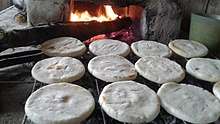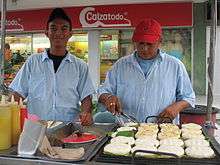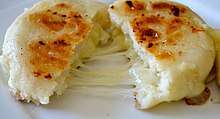Arepa
Arepa (Spanish pronunciation: [aˈɾepa]) is a type of food made of ground maize dough, originating from the northern region of South America in pre-Columbian times, and is notable in the cuisines of Colombia and Venezuela.[2][3]
 Arepas on a street stall | |
| Course | Any course |
|---|---|
| Place of origin | Pre-Colombian northern region of South America |
| Region or state | Northern region of South America |
| Associated national cuisine | Colombia, Venezuela |
| Created by | Timoto-Cuica people[1] |
| Main ingredients | Corn flour (maize meal or flour) |
It is eaten daily in those countries and can be served with accompaniments such as cheese, cuajada (fresh cheese), various meats, chicken, avocado, or diablito (deviled ham spread). It can also be split to make sandwiches. Sizes, maize types, and added ingredients vary its preparation. It is similar in shape to the Mexican gordita and the Salvadoran pupusa.
Origins
The arepa is a pre-Columbian dish from the area that is now Colombia and Venezuela. Instruments used to make flour for the arepas, and the clay slabs on which they were cooked, were often found at archaeological sites in the area. Although it has not been specified in which country an arepa was cooked for the first time, it has been possible to define the oldest dates of the presence of maize in Colombia and in Venezuela. For example, In Colombia, the first record of the existence of corn dates from about 3,000 years ago, while in Venezuela the estimate is about 2,800 years ago. In other words, the creation of the arepa most likely happened almost simultaneously in both countries, but well before either territory became a country with demarcated borders.[4]
Throughout its history, the arepa has stayed mainly unchanged from the arepas that pre-Columbian native peoples would have consumed, making the arepa one of the few pre-contact traditions that have remained popular in the years since colonization.[5]

Characteristics
The arepa is a flat, round, unleavened patty of soaked, ground kernels of maize, or—more frequently nowadays—maize meal or maize flour that can be grilled, baked, fried, boiled or steamed. The characteristics vary by color, flavor, size, and the food with which it may be stuffed, depending on the region. It can be topped or filled with meat, eggs, tomatoes, salad, cheese, shrimp, or fish depending on the meal.
Production
The flour is mixed with water and salt, and occasionally oil, butter, eggs, and/or milk. Because the flour is already cooked, the blend forms into patties easily. After being kneaded and formed, the patties are fried, grilled, or baked. Some varieties of arepas are made with "peeled" corn using the nixtamalization process.[6]
Arepa flour is specially prepared (cooked in water, then dried) for making arepas and other maize dough-based dishes, such as hallacas, bollos, tamales, empanadas and chicha. The flour may be called masarepa, masa de arepa, masa al instante, or harina precocida. The most popular brand names of maize flour are Harina PAN, Harina Juana, and Goya in Venezuela, and Areparina in Colombia.[7]
Regional varieties
Colombia


The arepa is an iconic food in Colombia, with some 75 distinct forms of preparation. According to a study conducted by the Colombian Academy of Gastronomy, "The arepa is part of the Colombian cultural heritage and can be considered a symbol of national gastronomic unity."[8]
In 2006, the arepa was named the cultural symbol of Colombia in a competition organized by Semana magazine with support from Caracol TV, the Minister of Culture and Colombia is Passion.[8]
In the Paisa Region, the arepa is especially important to the local people and sometimes accompanies all meals of the day. In addition, arepas are strung into necklaces and placed around the necks of honored dignitaries as a sign of praise.[8]
In Colombia, the arepa is sold on a commercial level in neighborhood stores, chain supermarkets and market plazas and packaged with preservatives as a pre-molded white or yellow corn dough that is ready to grill or fry at home.[9] It is also sold in the form of industrialized corn flour that requires hydration before preparation.[10] In addition, arepas are sold by street vendors, in cafeterias, and in neighborhood stores. Restaurants of the Paisa Region offer a wide variety of arepas, including a unique style of stuffed arepa that can be filled with eggs, meat, or cheese.[11]
The Colombian Arepa Festival is celebrated in the following five major cities: Bogotá, Medellín, Cali, Barranquilla, and Bucaramanga. According to the program calendar, each city takes turns organizing the festival between the months of August and December.[12]
Venezuela
The arepa is a symbol of Venezuelan gastronomy and one of the most common pre-Hispanic foods still popular in Venezuela.[5]
According to a 2015 survey of the Venezuelan people, nearly 70 percent of the nation ate arepas on a regular basis.[13] It is common for Venezuelans to eat arepas throughout the day, both as snacks and as sides to meals, creating a culture where these corn products can be found almost everywhere.[14] The arepa is seen as a cornerstone of a Venezuelan diet; previous to the 2015 food shortages, it was estimated that the average Venezuelan consumed about 30 kilos of the corn flour used to make arepas.[13] Venezuelan arepas are commonly filled with a great variety of different fillings, from beef and avocado to cheese, varying widely by the location of where they are sold and the ingredients that can be obtained.[5]
Decrease in consumption due to food shortages
Since the 2015 food shortages began, the consumption of arepas has significantly decreased.[13] These shortages have caused the citizens of Venezuela to be unable to obtain sufficient basic food supplies, including the corn flour used to make arepas, resulting in a decrease of corn flour consumption per capita from 30 kilos per year in 2014 to 17.5 in 2016.[13] These shortages have resulted in hours-long lines to buy government price-regulated corn flour as well as the creation of black markets selling flour at "many times the official cost."[5]
See also
References
- Gilbert G. Gonzalez; Raul A. Fernandez; Vivian Price; David Smith; Linda Trinh Võ (2 August 2004). Labor Versus Empire: Race, Gender, Migration. Routledge. pp. 142–. ISBN 978-1-135-93528-3.
- "Arepas". whats4eats. Retrieved 17 May 2012.
- "Arepas". picapica. Archived from the original on 16 July 2016. Retrieved 16 September 2016.
- Lovera, Patricia Sulbarán (2017). "¿De dónde es la arepa realmente: venezolana o colombiana?". BBC Mundo. Retrieved 2017-10-24.
- "Arepas Are Conquering The World — But Dying At Home In Venezuela". NPR.org. Retrieved 2017-10-24.
- https://www.canalrcn.com/el-desayuno/amp/recetas/receta-arepas-santandereanas-8387/
- Blazes, Marian. "Masarepa - Precooked Corn Flour for Making Arepas". About Food. Retrieved July 8, 2015.
- Revista Semana. "La arepa". Retrieved 11 January 2011.
- Gamba, Raúl Ricardo; Caro, Carlos Andrés; Martínez, Olga Lucía; Moretti, Ana Florencia; Giannuzzi, Leda; De Antoni, Graciela Liliana; Peláez, Angela León (17 October 2016). "Antifungal effect of kefir fermented milk and shelf life improvement of corn arepas". International Journal of Food Microbiology. 235: 85–92. doi:10.1016/j.ijfoodmicro.2016.06.038. hdl:11336/57193. PMID 27447094.
- Hernandez, Blanca; Guerra, Marisa; Rivers, Francisco (1999). "Obtención y caracterización de harinas compuestas de endospermo–germen de maíz y su uso en la preparación de arepas". Ciência e Tecnologia de Alimentos = Food Science and Technology (Campinas). 19 (2): 194–198. doi:10.1590/S0101-20611999000200007. ISSN 0101-2061.
- Winchester, Elizabeth (2014-09-26). "What's Cooking?". Time for Kids (Grades 5-6). Vol. 5 no. 3. p. 7.
- "El festival de la arepa colombiana". ELESPECTADOR.COM. December 18, 2008.
- Agropecuaria, Vision (2016-11-22). "Venezolanos consumen 12,5 kilos menos de harina de maíz precocida al año". Visión Agropecuaria (in Spanish). Retrieved 2020-05-11.
- "How Venezuelan Traditions Work". Traditional Venezuelan Food - How Venezuelan Traditions Work | HowStuffWorks. 2011-07-25. Retrieved 2017-10-24.
Further reading
- Food and Agricultural Organization, United Nations. Maize in Human Nutrition
- Dr. Nelson Solorzano, specialist in food and nutrition and in Caribbean Region Culture. Socio-economic Development Planner specialized in Latin American Socio-economic Development History, Agriculture and Culture. (CENDES-UCV), USA, May 2007
- De los timoto-cuicas a la invisibilidad del indígena andino y a su diversidad cultural
- Pequeña Historia de la Arepa|Author: Mariano Picón Salas| Suma de Venezuela. Caracas,1966

